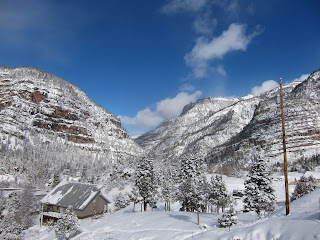Last month I had the opportunity to go out and take a look at an area with a lot of ice flows that hasn't yet seen much action. According to my partners, they had went into this particular area two years ago and found a tremendous amount of ice. There were big blue flows everywhere.
Well, we went in a bit on the early side and didn't find those flows.
A series of ice flows on Hall Peak that were not yet climbable.
Nearly a decade ago I wrote about Hall Peak in
Washington Ice: A Climbing Guide. There is one moderate route in the area called Silverton's Sickle. At the time of the writing, I had not been into the peak. I got the beta from the gentlemen who completed the first ascent of the line.
My friends completed the sickle in 2009 and then proceeded to climb a handful of first ascents in the horseshoe basin above the route. Based on what we saw on our recent trip into the area, they weren't lying. The lines just needed a bit more time.
We were a big group. There were six of us, which isn't always the best situation for making good choices in the alpine. But we did come to a group decision. We decided that if the ice climbs weren't in, then maybe we should try to climb Hall Peak itself.
We ascended a couloir up to a col at the base of the North Ridge (the Skubi Ridge). As we didn't have a guidebook, we weren't sure whether or not this route had been climbed. Apparently it had. It appears that the first ascent was made in 1962. But there is no evidence of a winter ascent...
One of my partners decided that he wanted to drop down the other side of the col toward the northeast face of the mountain. The face looked absolutely stellar. It was totally climbable...but maybe not totally protectable. Most of the face was covered in a couple of inches of ice. which would be fine for movement, but not necessarily fine for building anchors. And definitely not fine for a big team of six.
The Northeast Face of Hall Peak - The North Ridge is the
Right-Hand Skyline
We all dropped down and skirted below the face and climbed up a steep couloir, where it looked like there might be a way to attain the north ridge at a low saddle.
The Couloir - the Northeast Face is the the Right
There were two options to try. The first was to ascend a steep styrofoam snow slope. Both myself and one of the other climbers tried to do this, but found that the seventy-degree snow topped out on power covered slabs with no protection.
Looking up the slope. We knew that there would be no pro until the trees.
Unfortunately, the styrofoam ice ran out about twenty-feet below the trees, replaced by sugar snow on a slab.
Another view of the steep terrain above the couloir.
After retreating from this slope, we tried to climb through the top of the gully. There we found a steep rock step that was quite difficult to climb through. Both I and one of the other climbers tried this as well.
The author approaching the rock step.
Photo by Kevin Riddell
The author - about to start the rock step.
Photo by Kevin Riddell
The author - in the rock step. There was a bit of bad protection at the start, and the
crack to the left was chocked full of ice. When I tried to place a cam and pulled on it,
it slipped right out. I couldn't get into a good position to chip the ice out.
Photo by Kevin Riddell
The second climber was ultimately able to chip out enough ice to do some direct aid, but time was running short and we had to retreat.
Ultimately, we didn't get up Hall Peak. And in a full-day out in the field, I was only able to climb about a pitch of rock and ice. But it didn't matter...
There was a time when such a day would have been really frustrating for me. There was a time where I had the mantras, "summit or plummet," and "fingerlocks or cedar box," and "no mistake or big pancake." But those days are gone...
A summit is just a place. It may be a goal or even an obsession, but it's not the most important thing. Having a good day in the mountains with friends and coming back in one piece is far more important that any summit...
--Jason D. Martin






























